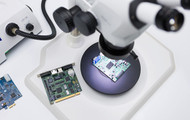Understanding Stereo Microscopes
Jun 30th 2019
Understanding Stereo Microscopes
Stereo microscopes are commonly used in both professional and amateur environments.
5 Key Stereo Microscope Facts
- Stereo microscopes have low magnification.
- Stereo microscopes create a 3-D image.
- Stereo microscopes do not require sample preparation.
- Stereo microscopes do not require use of a bottom (transmitted) light.
- Stereo microscopes are used to look at items you might hold in your hand - not cells.
In the educational environment, stereo microscopes are simple to use as they require no sample preparation. When using a compound biological microscope slide samples must be prepared prior to viewing. Sample preparation can be time-consuming and is not ideal for young children. Especially when kids are using the microscope, the association between the overall image viewed through the microscope of a prepared slide or a cross section is often lost. However, when a child can place a leaf, flower or insect directly on the stage and immediately view it through the microscope, they understand the connection between the sample being viewed under the microscope.
Stereo microscopes are available in a fixed magnification (for example 20x), dual magnification (10x & 30x), and the most popular zoom magnification.
 When purchasing a stereo microscope, one thing to consider is the field of view that the eyepieces provide. If you look at the eyepieces on a stereo microscope, the first number shown is the magnification (typically 10x), and the next number is the field of view in mm. The image at left shows 10x eyepieces with a 23mm field of view. A larger field of view is usually desired. If you are using a stereo microscope with eyepieces that have a field number (FN) of 23mm, when you set the objective lens value at 1x, the field of view will be 23mm. As you increase the magnification of the microscope by adjusting the zoom, the field of view will decrease.
When purchasing a stereo microscope, one thing to consider is the field of view that the eyepieces provide. If you look at the eyepieces on a stereo microscope, the first number shown is the magnification (typically 10x), and the next number is the field of view in mm. The image at left shows 10x eyepieces with a 23mm field of view. A larger field of view is usually desired. If you are using a stereo microscope with eyepieces that have a field number (FN) of 23mm, when you set the objective lens value at 1x, the field of view will be 23mm. As you increase the magnification of the microscope by adjusting the zoom, the field of view will decrease.
Stereo microscopes are typically used in the industrial manufacturing field for quality control to examine small parts. Often video inspection microscopes are used in this industry to reduce eye strain and fatigue. In education, stereo microscopes are used for dissection. Other industries that use stereo microscopes include museums, art galleries, filter patch inspection, gemologists, and electronics inspection.
Another consideration when purchasing a stereo microscope is whether or not you would like the ability to capture and save digital images. Some stereo microscopes include a monitor on the microscope, while others simply have a USB camera that connects to your computer and includes software.
If you have any questions about which stereo microscope is best for your application, contact Microscope World.
Read our Stereo Microscope Buying Guide





